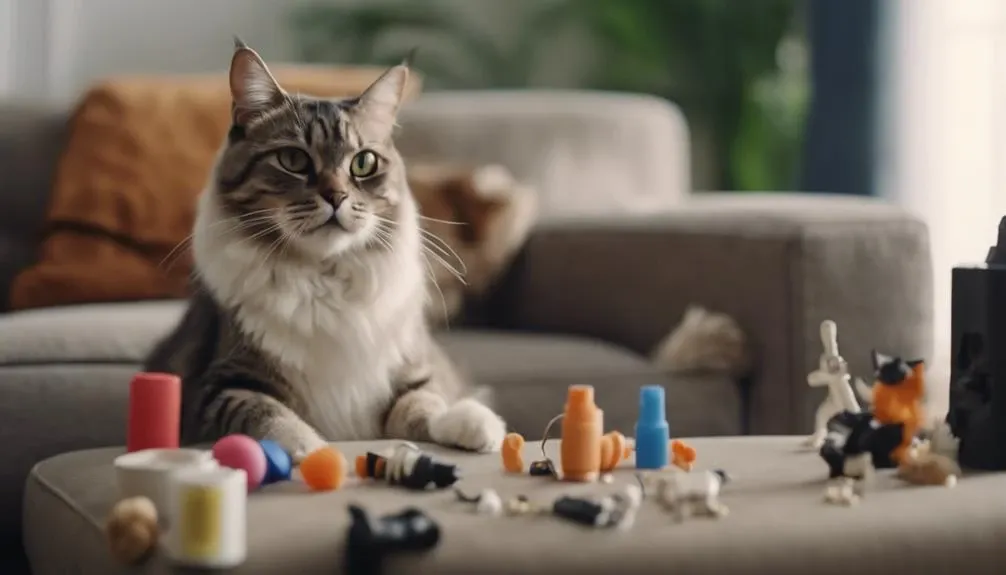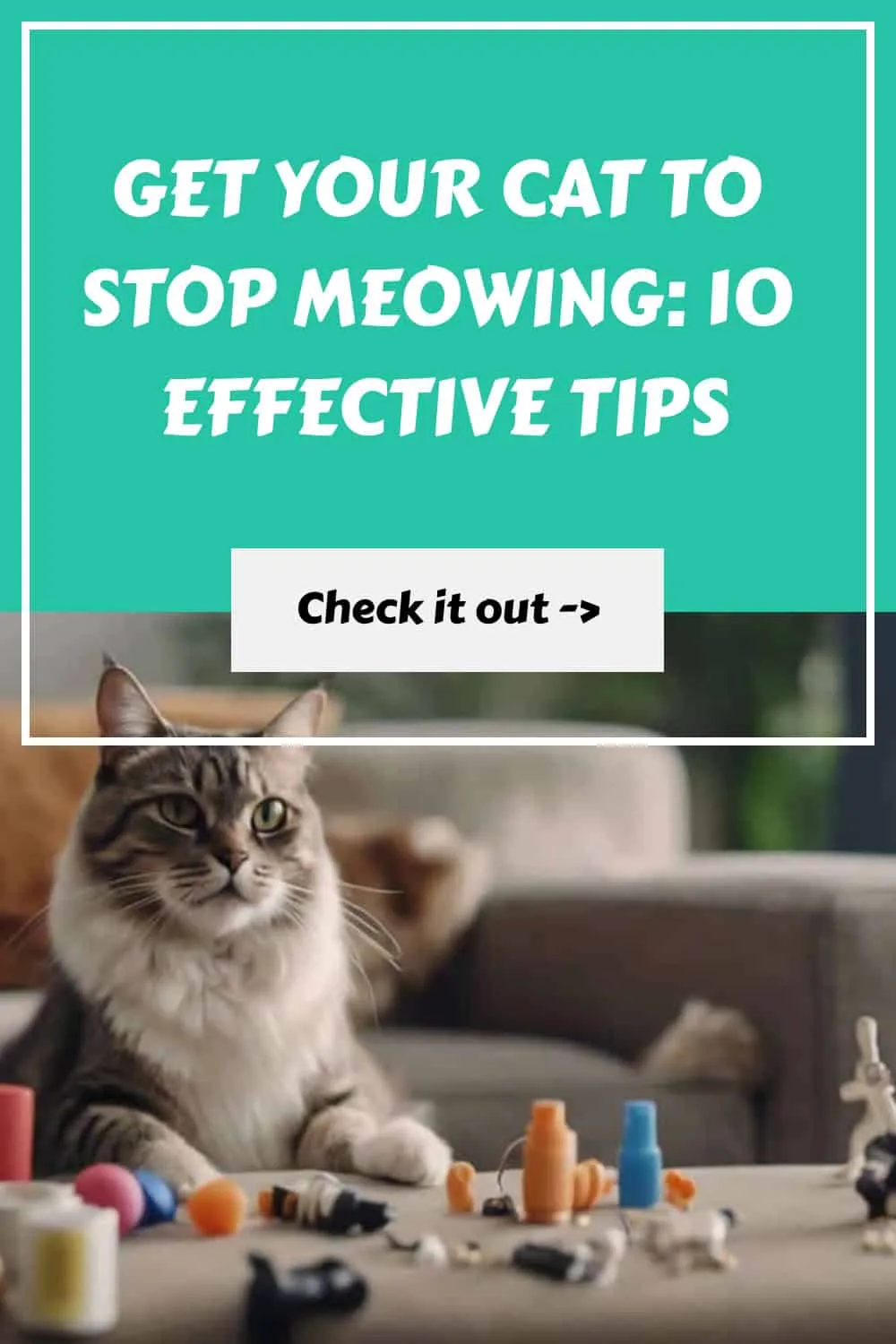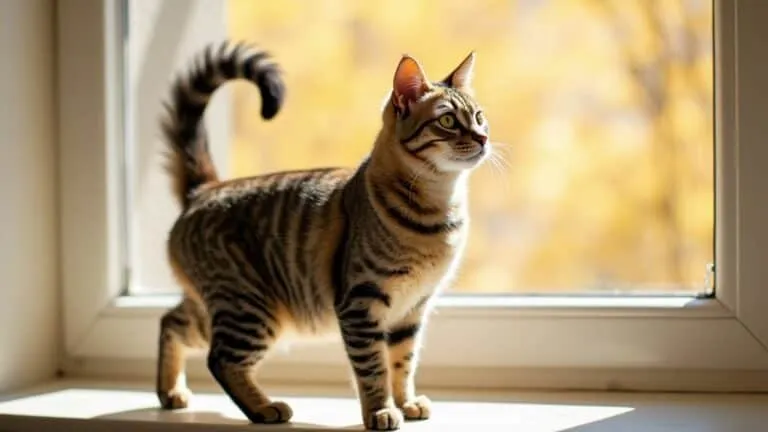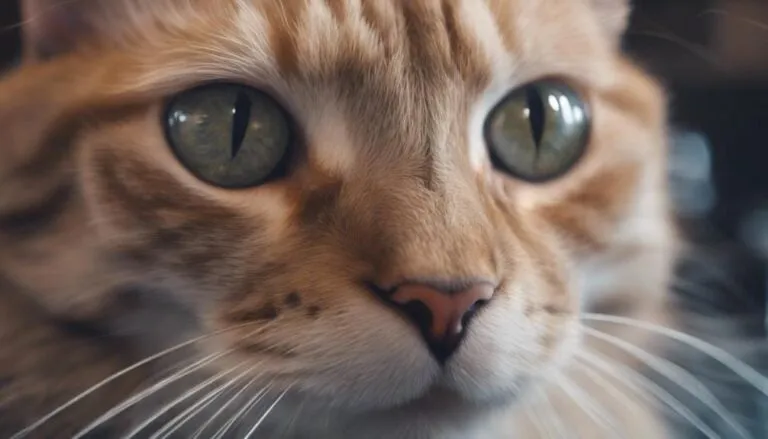The Best Fluffy Pancakes recipe you will fall in love with. Full of tips and tricks to help you make the best pancakes.

So, you've come to the point where you're starting to believe your cat's meows could rival a choir of angels.
However, before you consider earplugs as a viable solution, let's explore some effective tips to help silence your vocal feline companion.
From subtle environmental adjustments to engaging playtime strategies, there are ways to decode the language of meows and restore peace in your home.
Stay tuned to discover how you can finally reclaim your quietude amidst the symphony of meows.
Key Takeaways
- Establish routine feeding times and avoid free-feeding to regulate hunger cues and prevent excessive meowing.
- Provide mental stimulation through enrichment activities and interactive toys to reduce boredom and attention-seeking behaviors.
- Ensure a comfortable environment with clean litter boxes and cozy spaces to promote relaxation and reduce stress-related meowing.
- Seek professional help for medical concerns and develop customized behavior modification plans for effective reduction of meowing.
Enrichment Activities
To reduce your cat's excessive meowing, engage in enrichment activities like DIY puzzle feeders and interactive toys. These tools provide mental stimulation, keeping your cat engaged and less likely to meow excessively. Additionally, climbing structures and hiding spots offer a way for your cat to mimic its natural environment, promoting engagement and reducing meowing.
Rotating toys and introducing new ones regularly are crucial in preventing boredom and maintaining your cat's mental engagement, ultimately leading to less meowing. Creating a window perch can also be beneficial, as it allows your cat to watch outdoor activities, providing visual stimulation and alleviating restlessness.
Furthermore, engaging in play sessions with interactive toys such as feather wands can help channel your cat's energy positively, minimizing meowing. By incorporating these enrichment activities into your cat's routine, you can effectively reduce excessive meowing and ensure your cat remains mentally stimulated and content.
Establish Routine Feeding Times
To establish routine feeding times for your cat, setting consistent meal schedules and using feeding alarms can help regulate their hunger cues. Avoid free-feeding to prevent constant meowing for food and ensure you monitor their weight to adjust feeding amounts accordingly.
Creating a structured feeding routine can address hunger-related meowing and promote healthier eating habits for your cat.
Consistent Meal Schedule
Establishing a consistent meal schedule for your cat is crucial in regulating hunger and reducing excessive meowing. By following a routine feeding plan, you can help your cat anticipate meal times, decreasing anxiety and constant vocalizations.
Consistent meal times also provide a sense of security and structure for your feline friend, contributing to their overall well-being. Avoid free-feeding to prevent obesity and promote healthy eating habits. Regularly monitor your cat's weight and adjust portion sizes accordingly to maintain a healthy meal schedule.
- Feeding consistency: Establish a regular feeding routine to help your cat understand when to expect meals.
- Hunger cues: Pay attention to your cat's hunger signals to ensure they're adequately fed.
- Healthy portioning: Provide balanced meals in appropriate amounts to support your cat's health.
- Weight monitoring: Keep track of your cat's weight and adjust feeding portions as needed.
Set Feeding Alarms
Setting feeding alarms is a practical way to establish routine feeding times for your cat, ensuring they receive meals at consistent intervals to minimize excessive meowing. By incorporating feeding reminders or mealtime alerts into your daily schedule, you can help regulate your cat's hunger levels and reduce the likelihood of them meowing for food outside of designated meal times.
These alarms create a predictable routine that can also alleviate anxiety in cats, leading to less stress-induced meowing. Moreover, maintaining regular feeding times can contribute to your cat's healthy weight management, preventing overeating and constant meowing for additional food.
Provide Comforting Spaces
Creating comforting spaces for your cat is essential to providing them with a sense of security and relaxation in their environment. To ensure your feline friend feels safe and at ease, consider the following:
- Cozy Retreats: Cats need quiet and safe spaces to relax, away from potential stressors. Providing cozy hiding spots with blankets or beds can help them feel protected and calm.
- Elevated Sanctuaries: Cats enjoy elevated perches or cat trees as they give them a sense of security and a view of their surroundings, reducing anxiety.
- Exploration Opportunities: Encouraging your cat to explore cat-friendly spaces with hiding spots and cozy corners can help them feel more at ease in their territory.
- Multiple Hideaways: Offering hiding spots in different rooms allows your cat to retreat to various areas based on their comfort level and mood.
Address Medical Concerns
If your cat is meowing excessively, it's crucial to schedule a vet check-up to rule out any pain or illness. Common medical issues such as hyperthyroidism, dental problems, or urinary tract infections can cause increased vocalization.
Blood tests, physical exams, and diagnostic imaging may be necessary to determine the underlying cause of your cat's persistent meowing.
Vet Check-Up
Scheduling a veterinary check-up is crucial to rule out any underlying medical conditions that could be causing your cat's excessive meowing. Here are some key points to consider during the vet check-up:
- Medical issues like hyperthyroidism, dental problems, or urinary tract infections can lead to increased vocalization in cats.
- A thorough examination by a vet can help diagnose and treat any health issues contributing to the meowing behavior.
- Blood tests, urinalysis, and physical exams may be necessary to identify and address medical concerns related to your cat's meowing.
- Addressing medical concerns promptly can improve your cat's quality of life and reduce excessive meowing episodes.
Pain or Illness
To address medical concerns related to your cat's excessive meowing, monitoring your cat's behavior for signs of pain or discomfort is crucial. Look out for symptoms like limping, hiding, or changes in appetite. If you notice any of these signs, schedule a veterinary appointment to rule out underlying medical conditions causing the excessive meowing. Common health issues such as dental problems, urinary tract infections, and arthritis can lead to increased meowing. Your vet will provide recommendations for pain management and illness prevention if a medical problem is identified. Regular check-ups and preventive care play a vital role in early detection and management of potential health issues contributing to your cat's meowing.
| Pain Management | Illness Prevention |
|---|---|
| Vet-prescribed pain medications | Regular vaccinations |
| Comfortable resting areas | Balanced diet |
| Physical therapy exercises | Hygiene maintenance |
| Environmental enrichment | Stress reduction |
Ignore Attention-Seeking Meows
Ignoring attention-seeking meows in your cat can effectively discourage this behavior over time. When your feline companion starts meowing for attention, remember these key points to help modify this behavior:
- Avoid Reinforcement: Refrain from responding to your cat's meows to prevent reinforcing the behavior. By not giving in to the meowing, you communicate that this isn't how they'll get your attention.
- Consistency Matters: Consistently ignore the attention-seeking meows to convey the message effectively. Cats are quick to pick up patterns, so staying consistent is crucial for behavior modification.
- Reward Silence: Instead of rewarding meowing, reinforce moments of silence and calm behavior with attention or treats. This positive reinforcement encourages the desired behavior.
- Reduction Over Time: With persistent and consistent ignoring of attention-seeking meows, you can observe a reduction in excessive meowing as your cat learns that this behavior isn't effective in getting your attention.
Use Positive Reinforcement
When teaching your cat to exhibit desired behaviors, such as staying quiet, utilizing positive reinforcement techniques can be highly effective. Positive reinforcement involves rewarding your cat for the behaviors you want to encourage, like staying quiet. You can use treats, toys, or affection to reinforce your cat's quiet behavior effectively. Remember to ignore excessive meowing and only respond when your cat is quiet to reinforce the desired behavior further. Consistency is key when using reward-based training to modify your cat's behavior. By consistently rewarding your cat when they're quiet and not responding to excessive meowing, you can effectively reduce their meowing over time.
Reward-based training can be a powerful tool in behavior modification and can help your cat understand what behaviors are desirable. Be patient and persistent in applying positive reinforcement techniques, as it may take some time for your cat to learn the desired behavior. With dedication and consistency, you can effectively use positive reinforcement to decrease your cat's meowing and encourage quieter behavior.
Invest in Interactive Toys
Investing in interactive toys for your cat can significantly enrich their playtime activities, providing mental stimulation and physical exercise. These toys not only reduce boredom but also help minimize excessive meowing by keeping your cat engaged and satisfied.
Enriching Playtime Activities
To enhance your cat's playtime experience, consider incorporating interactive toys that stimulate their natural instincts and provide mental and physical engagement. Interactive toys can engage your cat's hunting instincts, offering mental stimulation and physical activity during playtime. Here are some tips to enrich your cat's playtime activities:
- Rotate toys regularly to keep playtime exciting.
- Use toys like laser pointers, feather wands, and treat-dispensing puzzles to entertain your cat.
- Interactive play sessions can strengthen the bond between you and your cat.
- Investing in high-quality interactive toys can promote healthy behavior and alleviate stress in your cat.
Reduce Boredom and Meowing
Consider incorporating interactive toys like puzzle feeders or laser pointers to engage your cat mentally and physically, reducing boredom and excessive meowing. Rotating these toys regularly can help maintain your cat's interest and prevent quick boredom. Toys that simulate hunting behaviors, such as wand toys or feather teasers, can satisfy your cat's natural instincts and deter constant meowing.
Additionally, providing scratching posts and climbing structures can keep your cat active and entertained, decreasing the chances of boredom-induced meowing. Engaging in daily interactive play sessions can strengthen your bond with your cat and offer mental stimulation, curbing the need for attention-seeking meows. For added enrichment, explore DIY puzzle feeders or create opportunities for outdoor exploration to further engage your feline companion.
Ensure Litter Box Hygiene
Maintaining a clean litter box daily is crucial to ensuring your cat's hygiene and happiness. Cats are meticulous creatures, and a dirty litter box can lead to unwanted meowing. To maintain a hygienic environment for your feline friend, follow these tips:
- Clean the litter box daily: Regular maintenance prevents odors and ensures your cat has a clean space to do their business.
- Choose the right litter: Opt for unscented, clumping litter that's comfortable for your cat's paws.
- Provide multiple litter boxes: Aim for one box per cat plus an extra one to prevent territorial issues and overcrowding.
- Regularly replace litter and scrub the box: This practice helps in keeping the area fresh and appealing to your cat.
Implement Quiet Time
Ensuring your cat's well-being involves creating a designated quiet time for relaxation and peace. Establish a meditation corner or relaxation space by providing a cozy area with soft bedding or a cat bed in a secluded spot. Encourage your cat to rest quietly in this designated area. It's essential to establish a routine for quiet time to help your cat associate specific times of the day with calmness and relaxation. Avoid disrupting your cat during quiet time to maintain a peaceful environment and reduce excessive meowing. Consider incorporating soothing background noise like classical music or white noise to help your cat relax further during quiet time.
| Quiet Time Tips | Description |
|---|---|
| Provide a cozy area | Create a designated relaxation space with soft bedding or a cat bed. |
| Establish a routine | Set specific times of the day for quiet time to promote calmness. |
| Use soothing background | Incorporate classical music or white noise to help your cat relax. |
Seek Professional Help
If your cat's excessive meowing persists despite trying various solutions at home, seeking professional help from a veterinarian or a behaviorist is crucial for tailored advice and potential underlying health issue assessment. Professional intervention can provide you with the necessary tools to address your cat's meowing effectively. Here are some reasons why seeking professional help is essential:
- Behavioral Modification: A behaviorist can offer expert advice on modifying your cat's meowing behavior through positive reinforcement and other proven techniques.
- Meowing Triggers: Professionals can help identify specific triggers that lead to excessive meowing and develop strategies to manage or eliminate these triggers.
- Health Issue Assessment: Veterinary professionals can conduct thorough examinations to rule out any underlying health issues that may be causing your cat to meow excessively.
- Customized Plan: With the help of professionals, you can create a customized plan tailored to your cat's unique needs, ensuring a more successful approach to stopping the meowing.
Frequently Asked Questions
How Do I Make My Cat Stop Meowing?
To help your cat stop meowing, try interactive toys and enrichment activities. Address underlying reasons like hunger or stress. Establish a consistent feeding schedule and create a calm environment. Consult a vet for guidance.
How Do I Get My Talkative Cat to Stop Meowing?
To help your talkative cat stop meowing, engage with interactive toys and enrichment activities. Address hunger, stress, or attention-seeking behaviors. Establish a routine, create a soothing environment, and consult a vet if excessive meowing persists for potential health concerns.
Should I Let My Cat Cry It Out?
When it comes to cat behavior and training methods, it's crucial to consider the impact of letting your cat "cry it out." Understanding your cat's needs and providing appropriate responses can help shape desirable behavior.
Can a Cat Be Trained to Stop Meowing?
You can train your cat to stop meowing by using positive reinforcement techniques and behavior modification. Consistent training, understanding your cat's reasons for meowing, and patience are key. Short, engaging sessions help in effective learning.
Conclusion
In conclusion, by understanding the reasons behind your cat's excessive meowing and implementing the ten effective tips provided, you can help your feline friend feel happier and more content.
Creating a peaceful environment, engaging in interactive playtime, and addressing any underlying medical concerns are key steps in reducing meowing behavior.
Remember, patience and consistency are key in helping your cat communicate in a healthier and more manageable way.










